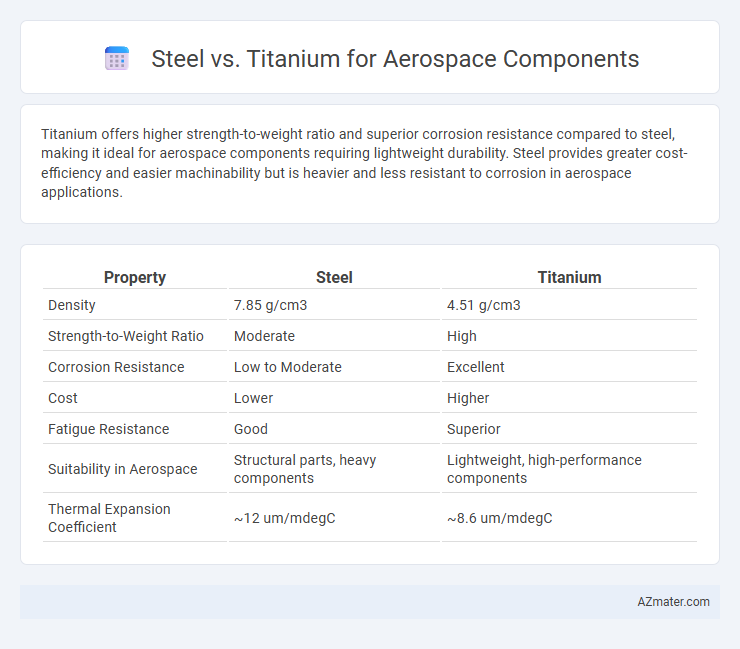Titanium offers higher strength-to-weight ratio and superior corrosion resistance compared to steel, making it ideal for aerospace components requiring lightweight durability. Steel provides greater cost-efficiency and easier machinability but is heavier and less resistant to corrosion in aerospace applications.
Table of Comparison
| Property | Steel | Titanium |
|---|---|---|
| Density | 7.85 g/cm3 | 4.51 g/cm3 |
| Strength-to-Weight Ratio | Moderate | High |
| Corrosion Resistance | Low to Moderate | Excellent |
| Cost | Lower | Higher |
| Fatigue Resistance | Good | Superior |
| Suitability in Aerospace | Structural parts, heavy components | Lightweight, high-performance components |
| Thermal Expansion Coefficient | ~12 um/mdegC | ~8.6 um/mdegC |
Introduction to Material Selection in Aerospace
Steel offers high strength and cost-effectiveness for aerospace components, making it suitable for structural parts demanding durability. Titanium provides exceptional strength-to-weight ratio and corrosion resistance, ideal for weight-critical applications and harsh environments. Material selection in aerospace balances mechanical properties, weight, corrosion resistance, and cost to optimize component performance and safety.
Overview of Steel and Titanium Alloys
Steel alloys in aerospace applications offer high strength, excellent fatigue resistance, and cost-effectiveness, commonly used in landing gear and engine components due to their durability and availability. Titanium alloys provide superior strength-to-weight ratio, corrosion resistance, and high-temperature performance, making them ideal for airframe structures and engine parts where weight reduction is critical. The choice between steel and titanium alloys depends on specific performance requirements, balancing mechanical properties and overall aircraft efficiency.
Mechanical Properties: Strength and Durability
Titanium offers superior strength-to-weight ratio compared to steel, making it ideal for aerospace components requiring high performance and weight reduction. Steel provides excellent durability and fatigue resistance but is significantly heavier, which can impact fuel efficiency in aircraft design. The unique combination of titanium's corrosion resistance and mechanical strength enhances longevity and reliability in aerospace environments, surpassing traditional steel alloys in critical applications.
Weight Considerations: Density and Mass Reduction
Titanium's density of approximately 4.5 g/cm3 is significantly lower than steel's average density of 7.85 g/cm3, enabling substantial mass reduction in aerospace components. This lower density results in lighter airframes and improved fuel efficiency, while maintaining comparable strength and corrosion resistance. Selecting titanium over steel reduces overall aircraft weight, directly enhancing payload capacity and operational performance.
Corrosion Resistance in Aerospace Environments
Titanium exhibits superior corrosion resistance compared to steel in aerospace environments due to its stable oxide layer that protects against oxidation and chemical attack. Steel, particularly stainless variants, can resist corrosion but often requires protective coatings to withstand harsh aerospace conditions such as salt spray and high humidity. Titanium's enhanced corrosion resistance ensures longer component lifespan and reduced maintenance in aerospace applications exposed to extreme environments.
Cost Analysis: Material and Manufacturing Expenses
Steel offers a significantly lower raw material cost compared to titanium, making it more budget-friendly for large-scale aerospace production. Manufacturing expenses for steel components benefit from established processing techniques and widespread availability of tooling, whereas titanium requires specialized machining and heat treatment, increasing overall fabrication costs. The total cost analysis favors steel when budget constraints dominate, but titanium's superior strength-to-weight ratio may justify higher expenses for critical aerospace applications.
Machinability and Fabrication Challenges
Steel offers superior machinability for aerospace components due to its well-understood machining properties and lower tool wear rates compared to titanium. Titanium poses fabrication challenges because of its high strength-to-weight ratio and tendency to work-harden, necessitating specialized tooling and slower machining speeds. The choice between steel and titanium impacts manufacturing efficiency, cost, and component performance in aerospace applications.
Fatigue Performance and Lifecycle
Titanium alloys exhibit superior fatigue performance compared to steel in aerospace components due to their high strength-to-weight ratio and excellent corrosion resistance, which significantly extends lifecycle durability under cyclic loading. Steel offers higher absolute strength but is prone to fatigue crack initiation and propagation, leading to shorter service intervals and increased maintenance costs. The lightweight nature of titanium reduces overall structural weight, enhancing fuel efficiency and reducing fatigue stress, thereby favoring its application in critical aerospace parts subject to repeated stress cycles.
Applications: Where Steel or Titanium Excels
Steel excels in aerospace applications requiring high strength, durability, and cost-effectiveness, making it ideal for landing gear, engine mounts, and structural frames where toughness under stress is critical. Titanium outperforms steel in components demanding lightweight properties, corrosion resistance, and high temperature endurance, such as airframes, engine parts, and fasteners in jet engines. The choice between steel and titanium depends on balancing factors like weight reduction, mechanical strength, and operational environment in aerospace design.
Conclusion: Optimal Choice for Aerospace Components
Titanium outperforms steel in aerospace components due to its superior strength-to-weight ratio and exceptional corrosion resistance, which contribute to fuel efficiency and durability. While steel offers higher tensile strength and lower cost, the weight penalty and susceptibility to corrosion limit its applications in critical aerospace parts. The optimal choice for aerospace components prioritizes titanium for structural and high-performance applications, balancing cost with long-term performance benefits.

Infographic: Steel vs Titanium for Aerospace Component
 azmater.com
azmater.com